Secession Crisis on the West Coast
During the secession crisis following Lincoln's election as President of the United States in 1860, a group of Southern sympathizers in California made plans to secede with Oregon to form a "Pacific Republic". Their plans rested on the cooperation of Colonel (Brevet Brigadier General) Albert Sidney Johnston, headquartered in Benicia, California, who commanded all the Federal troops of the Department of the Pacific. Johnston met with some of these Southern men, but before they could propose anything to him he told them that he had heard rumors of an attempt to seize the San Francisco forts and arsenal at Benicia, that he had prepared for that, and would defend the facilities under his command with all his resources and to the last drop of his blood. He told them to tell this to their friends. [2] Deprived of his aid, the plans for California and Oregon to secede from the United States never came to fruition. Meanwhile, Union men feared Johnston would aid such a plot and telegraphed Washington asking for his replacement. Brig. Gen. Edwin Vose Sumner was soon sent west via Panama to replace Johnston in March 1861. Johnston resigned his commission on 9 April, and after Sumner arrived on 25 April, Johnston turned over his command and moved with his family to Los Angeles.
On 28 March 1861, the newly formed Arizona Territory voted to separate from New Mexico Territory and join the Confederacy. This increased Union officials' fears of a secessionist movement to separate Southern California from the rest of California and join the Confederacy. This fear was based on the demonstrated Southern Californian desire for separation from the rest of California in the overwhelming vote for the 1859 Pico Act, the strength of secessionists in the area, and their declared intentions and activities, especially in forming militia companies.
Indian Wars in the Department of the Pacific
The campaign classification established by the United States National Park Service lists only one major campaign and battle in this theater, the Battle of Bear River. [21] However, there were several campaigns against various Indian tribes besides the eastern Shoshone, as described below.
In Northern California there was the ongoing Bald Hills War (1858–1864) against the Chilula, Lassik, Hupa, Mattole, Nongatl, Sinkyone, Tsnungwe, Wailaki, and Whilkut. From 12 December 1861, this theater was incorporated into the District of Humboldt with its headquarters at Fort Humboldt. The Bald Hills War was essentially a protracted irregular war requiring garrisons protecting settlements and escorting pack trains and also long patrols sometimes resulting in skirmishes.
California units remained in New Mexico Territory and west Texas as garrisons defending the area from a return of the Confederacy and fighting the Navajo and the Apache Wars until after the Civil War when they were relieved by Federal Troops in 1866.
In 1862-1863, California Cavalry units from the Southern California District fought the Owens Valley Indian War against the Owens Valley Paiutes, or Numa, and against their allies among the Kawaiisu in the Sierra Mountains to the west. [22]
Throughout the Civil War, Oregon and California Volunteer patrols had several clashes with the Ute, Goshute, Paiute, Bannock, and Shoshone bands in Oregon and the Territories of Washington (later Idaho), Utah, and Nevada (from 1863, the state of Nevada). However, the invasion of the territory of the Snake Indians by gold miners in 1863 brought on the Snake War. The Volunteers of California, Oregon, and Washington Territory fought the Snake Indians until relieved by Federal troops in late 1865; the war continued until 1868.
Other operations east of the Rocky Mountains and west of the Mississippi River are included in the Trans-Mississippi Theater.

The Drum Barracks, also known as Camp Drum and the Drum Barracks Civil War Museum, is the last remaining original American Civil War era military facility in the Los Angeles area. Located in the Wilmington section of Los Angeles, near the Port of Los Angeles, it has been designated as a California Historic Landmark, a Los Angeles Historic Cultural Monument and has been listed on the National Register of Historic Places. Since 1987, it has been operated as a Civil War museum that is open to the public.

Arizona Territory, colloquially referred to as Confederate Arizona, was an organized incorporated territory of the Confederate States that existed from August 1, 1861 to May 26, 1865, when the Confederate States Army Trans-Mississippi Department, commanded by General Edmund Kirby Smith, was surrendered at Shreveport, Louisiana. Effective Confederate control of the territory, however, had ended after the Battle of Glorieta Pass in March 1862.
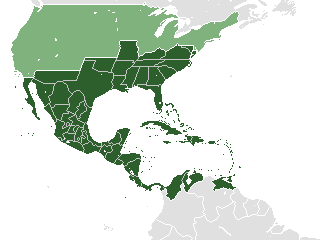
The Knights of the Golden Circle (KGC) was a secret society founded in 1854, the objective of which was to create a new country, known as the Golden Circle, where slavery would be legal. The country would have been centered in Havana and would have consisted of the Southern United States and a "golden circle" of territories in Mexico, Central America, northern parts of South America, and Cuba, Haiti, Dominican Republic, most other islands in the Caribbean, about 2,400 miles (3,900 km) in diameter.

The New Mexico campaign was a military operation of the Trans-Mississippi Theater of the American Civil War from February to April 1862 in which Confederate Brigadier General Henry Hopkins Sibley invaded the northern New Mexico Territory in an attempt to gain control of the Southwest, including the gold fields of Colorado and the ports of California. Historians regard this campaign as the most ambitious Confederate attempt to establish control of the American West and to open an additional theater in the war. It was an important campaign in the war's Trans-Mississippi Theater, and one of the major events in the history of the New Mexico Territory in the American Civil War.
The Department of the Pacific or Pacific Department was a major command (Department) of the United States Army from 1853 to 1858. It replaced the Pacific Division, and was itself replaced by the Department of California and the Department of Oregon.

California's involvement in the American Civil War included sending gold east to support the war effort, recruiting volunteer combat units to replace regular U.S. Army units sent east, in the area west of the Rocky Mountains, maintaining and building numerous camps and fortifications, suppressing secessionist activity and securing the New Mexico Territory against the Confederacy. The State of California did not send its units east, but many citizens traveled east and joined the Union Army there, some of whom became famous.
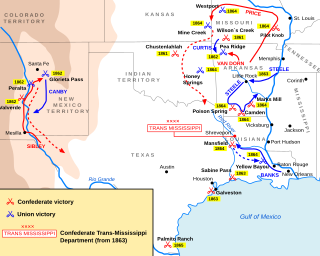
The Trans-Mississippi Theater of the American Civil War consists of the major military operations west of the Mississippi River. The area is often thought of as excluding the states and territories bordering the Pacific Ocean, which formed the Pacific Coast Theater of the American Civil War (1861–1865).

The 4th California Infantry was a volunteer infantry regiment recruited from northern California during the American Civil War. It was organized at Sacramento, Placerville, and Auburn in September and October 1861.
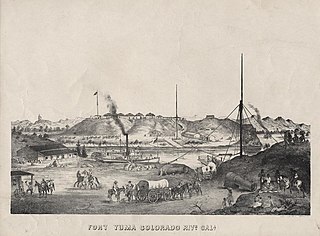
Fort Yuma was a fort in California located in Imperial County, across the Colorado River from Yuma, Arizona. It was on the Butterfield Overland Mail route from 1858 until 1861 and was abandoned May 16, 1883, and transferred to the Department of the Interior. The Fort Yuma Indian School and the Saint Thomas Yuma Indian Mission now occupy the site. It is one of the "associated sites" listed as Yuma Crossing and Associated Sites on the National Register of Historic Places in the Yuma Crossing National Heritage Area. In addition, it is registered as California Historical Landmark #806.

The New Mexico Territory, which included the areas which became the modern U.S. states of New Mexico and Arizona as well as the southern part of present-day Nevada, played a small but significant role in the Trans-Mississippi Theater of the American Civil War. Despite its remoteness from the major battlefields of the east and its existence on the still sparsely populated and largely undeveloped American frontier, both Confederate and Union governments claimed ownership over the territory, and several important battles and military operations took place in the region.

The 1st Regiment California Volunteer Infantry was an infantry regiment in the Union Army during the American Civil War. It spent its entire term of service in the western United States.

Oak Grove Butterfield Stage Station is located in the western foothills of the Laguna Mountains, in northern San Diego County, California. It is located on State Route 79, 13 miles (21 km) northwest of Warner Springs and Warner's Ranch. The station was built on the site of Camp Wright, an 1860s Civil War outpost.

The District of Oregon was a Union Army command department formed during the American Civil War.
The Department of New Mexico was a department of the United States Army during the mid-19th century. It was created as the 9th Department, a geographical department, in 1848 following the successful conclusion of the Mexican–American War, and renamed Department of New Mexico in 1853. It had to contend with an invading Confederate force during the New Mexico Campaign of the American Civil War from mid-1861 to early 1862, then with Apache tribes during the remainder of the conflict. It was merged into the Department of California after the end of the war as the District of New Mexico.
The District of California was a Union Army command department formed during the American Civil War. The district was part of the Department of the Pacific, the commander of the department also being District commander. The district was created as a separate command on July 1, 1864, after Irvin McDowell took command of the Department of the Pacific, relieving General Wright, who then remained as District of California commander. The District comprised the state of California and the areas of the Rogue River and Umpqua River in Southern Oregon. Its headquarters were in San Francisco, co-located with those of the Department of the Pacific. On March 14, 1865, the District of Oregon was extended to include the entire state of Oregon, removing the Rogue River and Umpqua River areas from the District.
J. M. Chapman, a 90-ton schooner, was purchased in 1863, by Asbury Harpending and other California members of the Knights of the Golden Circle in San Francisco to outfit as a Confederate privateer.
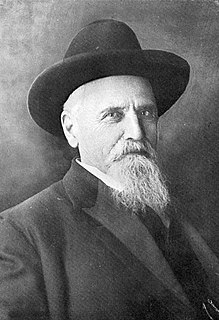
Asbury Harpending was an adventurer and financier in San Francisco, California, Mexico, and New York City.
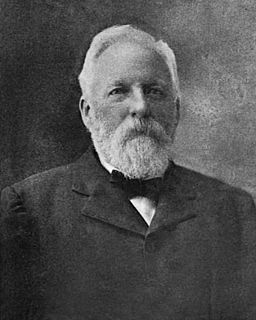
Clarence Edmund Bennett (1833–1902), usually referred to as Clarence E. Bennett, a graduate of West Point, a career American Army officer who saw duty almost exclusively in Western frontier assignments, served in the American Civil War in California, New Mexico and Arizona Territories and later in Reconstruction occupation forces and frontier duty during the later Indian Wars.
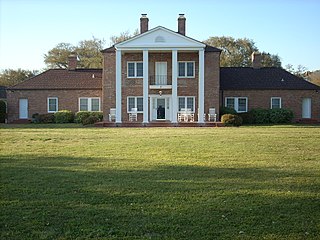
Fort Johnston was a British fort, later a United States Army post, in Brunswick County, North Carolina on Moore Street near Southport, North Carolina. It stands on the west bank of the Cape Fear River, four miles above its mouth.

The role of Washington Territory in the American Civil War is atypical, as the territory was the most remote from the main battlefields of the conflict. The territory raised a small number of volunteers for the Union Army, who did not fight against the Confederate States Army but instead maintained defensive positions against possible foreign naval or land attacks. Although the Indian Wars in Washington were recent, there were no Indian hostilities within the area of modern Washington, unlike the rest of the western states and territories, during the Civil War. At the start of the American Civil War, modern-day Washington was part of the Washington Territory. On March 3, 1863, the Idaho Territory was formed from that territory, consisting of the entirety of modern-day Idaho, Montana, and all but southwest Wyoming, leaving the modern-day Washington as Washington Territory.














